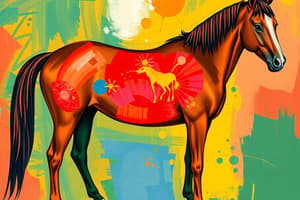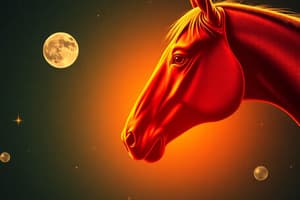Podcast
Questions and Answers
A horse presents with clinical signs of liver disease, but laboratory tests do not definitively confirm hepatic failure. What percentage of functional hepatic mass is typically impaired before laboratory tests consistently detect liver dysfunction?
A horse presents with clinical signs of liver disease, but laboratory tests do not definitively confirm hepatic failure. What percentage of functional hepatic mass is typically impaired before laboratory tests consistently detect liver dysfunction?
- 20%
- 65%
- 50%
- 80% (correct)
Which clinical sign is least specific in horses with hepatic encephalopathy (HE)?
Which clinical sign is least specific in horses with hepatic encephalopathy (HE)?
- Aimless walking
- Head pressing
- Mild Colic (correct)
- Excessive yawning
An equine patient presents with elevated bilirubin levels. If direct bilirubin is greater than 30% of the total bilirubin, which condition should be highly suspected?
An equine patient presents with elevated bilirubin levels. If direct bilirubin is greater than 30% of the total bilirubin, which condition should be highly suspected?
- Pre-hepatic hyperbilirubinemia
- Cholelithiasis (correct)
- Hemolytic anemia
- Anorexia-related hyperbilirubinemia
Following liver biopsy in a horse, histopathology reveals megalocytosis, biliary hyperplasia, and fibrosis. Which toxic insult is most likely to cause these changes?
Following liver biopsy in a horse, histopathology reveals megalocytosis, biliary hyperplasia, and fibrosis. Which toxic insult is most likely to cause these changes?
Which of the following statements regarding the pathogenesis of equine hyperlipemia is most accurate?
Which of the following statements regarding the pathogenesis of equine hyperlipemia is most accurate?
What is the rationale behind using heparin in the treatment of equine hyperlipemia, considering its potential effects on lipoprotein lipase?
What is the rationale behind using heparin in the treatment of equine hyperlipemia, considering its potential effects on lipoprotein lipase?
Which of the following is the most accurate description of the pathophysiology of pyrrolizidine alkaloid toxicity in horses?
Which of the following is the most accurate description of the pathophysiology of pyrrolizidine alkaloid toxicity in horses?
When evaluating liver function in horses, clinicians often use serum bile acid measurements. Which of the following best describes a key consideration for interpreting these measurements accurately?
When evaluating liver function in horses, clinicians often use serum bile acid measurements. Which of the following best describes a key consideration for interpreting these measurements accurately?
Which statement best explains why Tyzzer's disease is particularly devastating in foals?
Which statement best explains why Tyzzer's disease is particularly devastating in foals?
What is the primary mechanism by which insulin aids in the treatment of equine hyperlipemia?
What is the primary mechanism by which insulin aids in the treatment of equine hyperlipemia?
Which of the following statements accurately describes the role and interpretation of Aspartate aminotransferase (AST) in evaluating equine liver disease?
Which of the following statements accurately describes the role and interpretation of Aspartate aminotransferase (AST) in evaluating equine liver disease?
When managing a horse with liver disease, why is it important to provide small and frequent feedings of easily digestible carbohydrates, even if the horse is also in a negative energy balance?
When managing a horse with liver disease, why is it important to provide small and frequent feedings of easily digestible carbohydrates, even if the horse is also in a negative energy balance?
How do the liver's metabolic pathways contribute to the development of hyperlipemia in horses experiencing a negative energy balance?
How do the liver's metabolic pathways contribute to the development of hyperlipemia in horses experiencing a negative energy balance?
Why is blood ammonia concentration monitoring crucial in equine liver disease, and what does an elevated level typically indicate?
Why is blood ammonia concentration monitoring crucial in equine liver disease, and what does an elevated level typically indicate?
Considering Theiler's disease, which factor has been most recently identified as a potential cause of this condition, and what implications does this have for equine health management?
Considering Theiler's disease, which factor has been most recently identified as a potential cause of this condition, and what implications does this have for equine health management?
In horses with suspected cholelithiasis, why is ultrasound a critical diagnostic tool, and what specific findings would strongly suggest the presence of biliary calculi?
In horses with suspected cholelithiasis, why is ultrasound a critical diagnostic tool, and what specific findings would strongly suggest the presence of biliary calculi?
Why are antibiotics commonly administered in equine liver disease cases, even when there's no definitive evidence of bacterial infection?
Why are antibiotics commonly administered in equine liver disease cases, even when there's no definitive evidence of bacterial infection?
A practitioner is considering the use of pentoxifylline for a horse with chronic liver disease. What is the primary pharmacological action of pentoxifylline in this scenario, and what specific benefit is it intended to provide?
A practitioner is considering the use of pentoxifylline for a horse with chronic liver disease. What is the primary pharmacological action of pentoxifylline in this scenario, and what specific benefit is it intended to provide?
What is the significance of apolipoprotein B-48 in the development of hyperlipemia in ponies compared to horses?
What is the significance of apolipoprotein B-48 in the development of hyperlipemia in ponies compared to horses?
When is the measurement of blood urea nitrogen (BUN) most relevant in the context of equine liver health, and what does a decreased BUN concentration typically indicate?
When is the measurement of blood urea nitrogen (BUN) most relevant in the context of equine liver health, and what does a decreased BUN concentration typically indicate?
Flashcards
Hepatic Insufficiency and Failure
Hepatic Insufficiency and Failure
Liver is highly regenerative, with functions unimpaired until 80% of mass is lost; can occur without clinical signs but detectable by lab tests.
Clinical signs of hepatic disease
Clinical signs of hepatic disease
Non-specific signs include anorexia, depression, mild colic, icterus, weight loss, and fever, which can progress to hepatic encephalopathy (HE).
Clinical signs of Hepatic Encephalopathy
Clinical signs of Hepatic Encephalopathy
Excessive yawning, altered mentation, stupor, unawareness, head pressing, aimless walking, unconsciousness, and recumbency.
Hyperbilirubinemia in Liver Disease
Hyperbilirubinemia in Liver Disease
Signup and view all the flashcards
Direct (conjugated) bilirubin
Direct (conjugated) bilirubin
Signup and view all the flashcards
Liver enzymes
Liver enzymes
Signup and view all the flashcards
Sorbitol dehydrogenase (SDH)
Sorbitol dehydrogenase (SDH)
Signup and view all the flashcards
Aspartate aminotransferase (AST)
Aspartate aminotransferase (AST)
Signup and view all the flashcards
Alkaline phosphatase (ALP)
Alkaline phosphatase (ALP)
Signup and view all the flashcards
Gamma-glutamyl transpeptidase (GGT)
Gamma-glutamyl transpeptidase (GGT)
Signup and view all the flashcards
General treatment of liver disease
General treatment of liver disease
Signup and view all the flashcards
Equine Hyperlipemia
Equine Hyperlipemia
Signup and view all the flashcards
Hypertriglyceridemia
Hypertriglyceridemia
Signup and view all the flashcards
Hyperlipemia Diagnosis
Hyperlipemia Diagnosis
Signup and view all the flashcards
Hyperlipemia Treatment
Hyperlipemia Treatment
Signup and view all the flashcards
Theiler's Disease
Theiler's Disease
Signup and view all the flashcards
Tyzzer's Disease
Tyzzer's Disease
Signup and view all the flashcards
Bacterial cholangiohepatitis
Bacterial cholangiohepatitis
Signup and view all the flashcards
Toxic Hepatopathy
Toxic Hepatopathy
Signup and view all the flashcards
Pyrrolizidine Alkaloid Toxicity
Pyrrolizidine Alkaloid Toxicity
Signup and view all the flashcards
Study Notes
Equine Liver Disease
- Biochemical tests are important to evaluate liver disease and function in horses.
Hepatic Insufficiency and Failure
- The liver has high regenerative capabilities.
- Most hepatic functions remain unimpaired until the loss of over 80% of hepatic mass.
- Liver disease can occur without leading to liver failure.
- Hepatic disease does not always show clinical signs, but can be found by lab tests.
Clinical Signs of Hepatic Disease
- Often nonspecific, including anorexia, depression, mild colic, icterus, weight loss, and fever.
- Progression to failure causes hepatic encephalopathy (HE), photosensitization, bilateral laryngeal paralysis, and bleeding.
Clinical Signs of Hepatic Encephalopathy (HE)
- Excessive yawning, altered mentation, stupor, unawareness, head pressing, aimless walking, unconsciousness, and recumbency.
Diagnosis of Liver Disease
- Largely based on clinical chemistry.
- Hyperbilirubinemia is not very specific and rises occur due to liver disease, hemolysis, and anorexia.
- Indirect (unconjugated) bilirubin elevates with all three issues.
- Direct (conjugated) bilirubin elevation can indicate liver disease, but is not always present.
- Elevated direct bilirubin, greater than 30% of total bilirubin, indicates a post-hepatic issue like cholelithiasis.
Liver Enzymes
- Four common enzymes are assessed - two hepatocellular and two biliary.
- All four enzymes increase with either hepatocellular or biliary disease.
- Sorbitol dehydrogenase (SDH) is a hepatocellular specific enzyme.
- SDH is very sensitive with a short half-life.
- Interpretation is difficult if analysis is delayed.
- Aspartate aminotransferase (AST) is found in hepatocytes and muscle cells, making it non-specific.
- With elevations, always evaluate CK.
- ALT is not useful in LA.
- Alkaline phosphatase (ALP) is a non-specific enzyme, but usually increases with biliary diseases.
- Other sources are bone, intestine, kidney, placenta, and leukocytes.
- Gamma-glutamyl transpeptidase (GGT) is a specific biliary enzyme.
- GGT has a long half-life.
- Many clinicians find GGT very useful.
Serum Bile Acids
- Bile acids are an indicator of liver function replacing foreign dye clearances.
- Horses do not typically need to be fasted for bile acid measurements.
- Increases in bile acids occur with liver and cholestatic disease, with larger increases in cholestatic disease.
Albumin
- Hypoalbuminemia is uncommon in horses due to the long half-life of albumin compared to other species.
- Decreases can be seen in end-stage liver disease.
Blood Urea Nitrogen (BUN)
- BUN concentrations decrease with significant liver disease and failure.
Blood Ammonia Concentrations
- Blood ammonia increases with liver disease or failure.
- High ammonia is often seen with hepatoencephalopathy.
- measuring ammonia is expensive.
Coagulation Factors
- Changes in hemostasis can occur with significant liver disease or failure.
Ultrasound
- Ultrasound and liver biopsy are commonly used.
- Ultrasounds can find dilated bile ducts or obstructions, abscesses, cysts, or neoplasia.
- Ultrasound-guided liver biopsies are used for histology or culture.
- Evaluations of hemostasis (OSPT, APTT) are typically done prior to biopsy.
General Liver Disease Treatment
-
Treatment is often supportive.
-
Fluid therapy depends on severity of disease.
- Electrolyte, acid-base and hypoglycemia are common in severe cases.
-
Anti-inflammatory drugs like NSAIDs (flunixin), DMSO, and pentoxifylline are used.
-
Nutrition includes small, frequent feedings of easily digestible carbohydrates, like grain or equine senior with lower protein.
- Eating carbohydrates is important (alfalfa hay is a good source, but is high in protein).
-
Drugs to decrease fibrosis include pentoxifylline and colchicine.
-
Drugs to reduce ammonia in the GIT (or reduce absorption) are mineral oil, neomycin, and lactulose, although these can cause diarrhea.
-
Antibiotics are commonly used due to concerns about bacterial cholangiohepatitis.
-
Equine liver disease is not uncommon, but the exact cause often remains unknown even with thorough diagnostics.
-
Treatment is largely supportive, with antibiotics used even without evidence of bacterial infections.
Equine Hyperlipemia
- Hyperlipemia is a condition affecting miniature horses, donkeys, and ponies with negative energy balance.
- Horses develop hypertriglyceridemia and hepatic lipidosis, but not ketosis.
Definitions for Equine Hyperlipemia
- Hypertriglyceridemia means elevated serum triglyceride concentrations.
- Hyperlipidemia describes an increase in serum triglyceride concentration above normal, generally less than 500 mg/dl, without visible lipemia of plasma.
- This also occurs without evidence of fat infiltration of body tissues or organs.
- Hyperlipemia is an increase in serum triglyceride concentrations, usually greater than 500 mg/dl, along with gross lipemia of the plasma and fat infiltration of body tissues/organs.
- Severe hypertriglyceridemia in normal-sized horses shows triglyceride concentrations higher than 500 mg/dl with fat infiltration into organs not typically reported.
Signalment and Clinical Signs of Hyperlipemia
- Commonly affects miniature horses, ponies, and donkeys, especially females and obese animals.
- History of negative energy balance includes late gestation, lactating mares, heavy parasite load, and any disease resulting in anorexia.
- Non-specific clinical signs feature depression, anorexia, weakness, and decreased fecal production.
Progression results in hepatic lipidosis and liver failure.
- Clinical signs of hepatic lipidosis include colic from stretching of the liver capsule and hepatoencephalopathy.
- abortion and renal failure can occur in pregnant mares.
Normal Triglyceride Metabolism
- During negative energy balance, triglycerides undergo lipolysis in adipocytes via hormone-sensitive lipase, releasing free fatty acids (FFA) and glycerol into circulation.
- FFA in the liver can be oxidized for energy via acetyl CoA, partially oxidized for ketone production and re-esterified to produce triglycerides.
- Ketone production is poorly developed in the horse.
- The liver releases triglycerides into circulation as very-low-density-lipoproteins (VLDL).
- Peripheral tissues release FFA from VLDL via lipoprotein lipase and use it for energy.
- Hyperlipemia results from negative energy balance, increasing hormone-sensitive lipase activity where released FFA exceeds the liver's oxidative capacity.
- FFA are re-esterified into triglycerides then released back as VLDL, overwhelming peripheral tissues.
- Hepatic lipidosis results when VLDL release overwhelms peripheral tissue uptake, leading to liver disease, liver failure, or liver rupture.
- Hyperlipemia is not due to the reduced ability to clear VLDL, but the overproduction of triglycerides and VLDL from the liver.
- Ponies and minis have a different VLDL type caused by a different apolipoprotein in the VLDL (apolipoprotein B-48) which results in greater triglyceride concentrations.
- A diagnosis of hyperlipemia is suspected based on signalment and history of negative energy balance, and clinical signs.
- A preliminary diagnosis shows opaque plasma and a confirmed diagnosis includes lipemic serum/plasma, triglyceride concentrations higher than 500 mg/dL, and evidence of organ dysfunction.
- Hyperlipidemia is also commonly diagnosed where horses displaying the signs should be monitored.
- Normal triglyceride concentrations in adult horses/ponies are less than 85 mg/dl.
- Normal triglyceride concentrations are up to 290 mg/dl in donkeys and 250 mg/dl in pregnant ponies.
Treatment Aims
-
Increase caloric intake, treat underlying disease, decrease fat mobilization from adipose tissue while increasing triglyceride uptake.
-
Increasing caloric intake includes frequent offerings of highly palatable food like green grass or concentrated carbohydrates.
- Other methods include assisted enteral feeding using a nasogastric tube with water-soaked pellets or commercial powdered formulas, and total or partial parenteral nutrition.
-
Treat underlying disease and negative energy balance, such as weaning the foal if lactating or terminating pregnancy if pregnant and resolving underlying issues speeds up recovery.
-
Decreasing fat mobilization and increasing triglyceride uptake can be done but with some caveats.
-
Heparin increases lipoprotein lipase activity, but activity is already increased with hyperlipemia not due to decreased triglyceride uptake.
-
Insulin, with concurrent dextrose administration, has an antagonistic effect on lipolysis but carries a hypoglycemia risk when using parenteral nutrition.
Theiler’s Disease
-
Theiler’s Disease is serum sickness, acute hepatic necrosis, or serum-associated hepatitis with recent reports showing equine parvovirus-hepatitis contamination of biological products.
-
Its development is associated with the administration of biological products to horses weeks to months after administration often caused by tetanus antitoxin.
-
It affects adult horses.
-
Clinical signs include liver that often progress to liver failure.
-
Diagnosis consists of history of biologics, blood work and clinical signs supportive of the diagnosis, and by widespread centrolobular to midzonal hepatocellular necrosis with hemorrhage.
-
Treatment is supportive with a poor prognosis and signs of liver failure.
Tyzzer’s Disease
- Is a bacterial infection of the liver is caused by Clostridium piliformis
- This infection effects foals from 7 to 42 days with outbreaks that have been reported
- Clinical signs feature liver disease that progresses to liver failure and dead foals are common.
- Diagnosis considers liver disease in foals, confirmed by necropsy or biopsy with sliver stain for C. piliformis. A PCR test is available but difficult to culture
- Treatment with penicillin and supportive care is highly fatal.
- Transmission occurs when foals ingest C. piliformis from feces or soil and the bacteria replicate in the intestinal epithelium that spread to the liver.
Other Bacterial Infections
- Other Bacterial Infections most likely include bacterial cholangiohepatitis, which can ascend into the liver and is typically caused by enterocolitis and intestinal obstruction.
- Primary bacterial hepatitis is rare.
- These occur in adult horses with or without a history of gastrointestinal disease where it is less common to see evidence of liver failure.
- Diagnosis is based on liver biopsy, and treatment is provided with antimicrobial drugs usually based on culture and sensitivity.
Toxic Hepatopathy
- Toxic Hepatopathy is caused by plants, chemicals, drugs, and mycotoxins, where clinical signs and tests do not distinguish them except for pyrrolizidine alkaloid toxicity confirmed by liver biopsy.
- Diagnosis requires identifying the toxin.
- Plants include kleingrass, lecheguilla, sneezeweed, blue-green algae, rye grass and mushrooms and exposure usually causes chronic hepatitis and fibrosis.
Pyrrolizidine Alkaloid
- Pyrrolizidine alkaloid toxicity causes megalocytic hepatopathy, common in chronic liver disease in parts of the US, often caused by Senecio spp, Amsinckia spp, Crotalaria spp and Heliotropium spp.
- These plants are unpalatable, but horses consume them if other forage is lacking.
- The effects of the toxins are cumulative, and toxicity develops due to lack of other forage following chronic low-level exposure such as ingesting pyrrolizidine alkaloids which metabolize into toxic pyrrole derivatives causing the cells to enlarge.
- Pyrroles inhibit cellular replication and protein synthesis, preventing cell division, resulting in megalocytosis. When these megalocytes die, fibrosis develops.
- Clinical signs develop 4-12 weeks after consumption that often progresses to liver failure.
- Diagnosis includes a history of exposure and clinical signs, with liver biopsy (megalocytosis, biliary hyperplasia, and fibrosis).
- There is no specific treatment.
- Mycotoxins are potentially hepatotoxic, with Fumonisin B1 causing moldy corn poisoning that can cause hepatic disease.
Cholelithiasis
- Cholelithiasis, or biliary calculi, commonly affect adult, middle-aged horses and is signaled by clinical signs of liver disease that typically doesn't progress to liver failure, but colic and fever do occur.
- Most choleliths in horses consist of calcium bilirubinate and are associated with bacterial cholangitis due to unknown sequences.
- Diagnosis includes blood work elevations in GGT and bile acids, and often diagnosis by ultrasound shows dilated bile ducts, and hyper foci in bile ducts.
- Treatment most commonly includes long-term antibiotics and supportive medical care although surgery may be required in limited cases with mixed success.
- The prognosis depends on extent of hepatic fibrosis, and size of the choleliths.
Studying That Suits You
Use AI to generate personalized quizzes and flashcards to suit your learning preferences.




